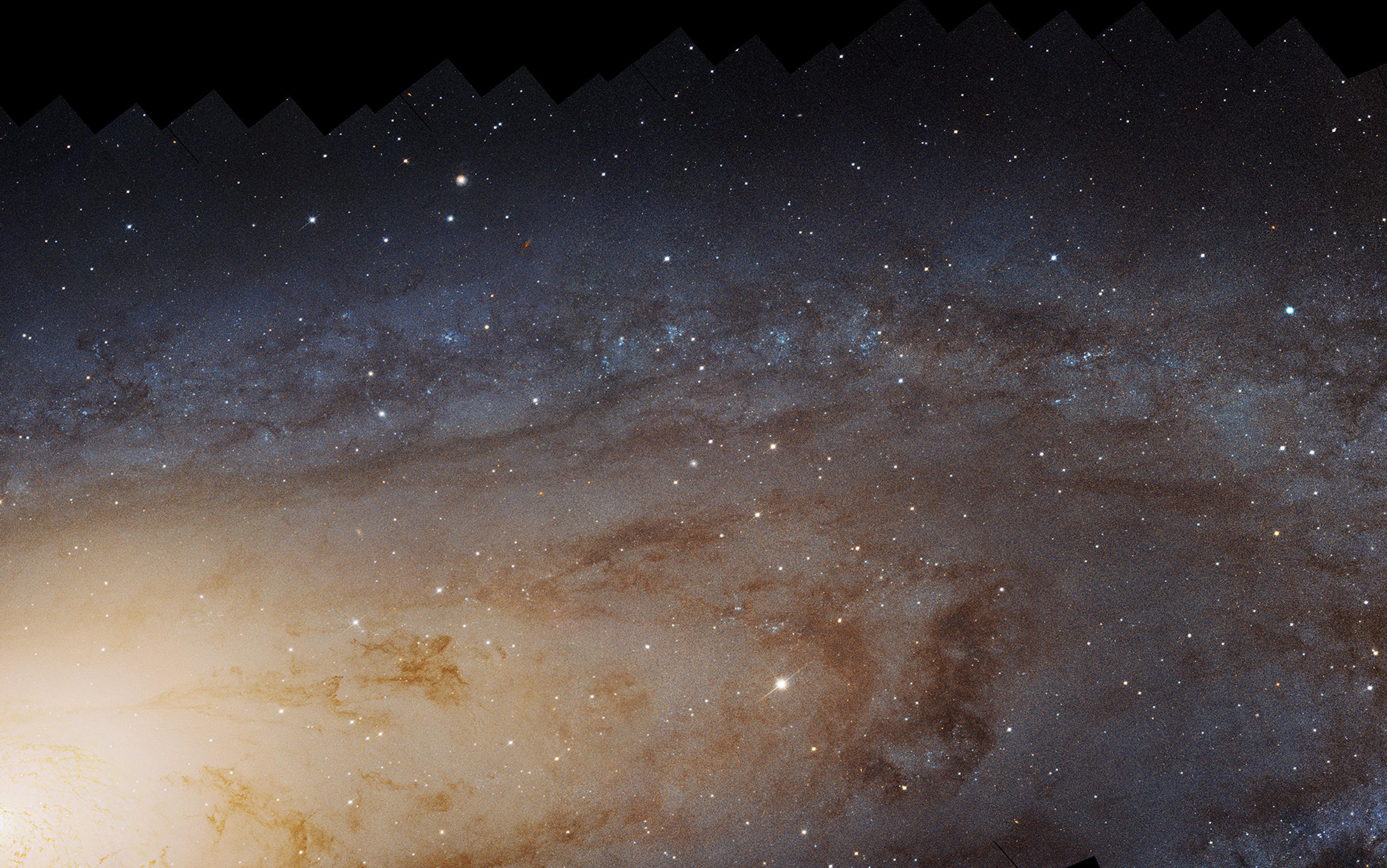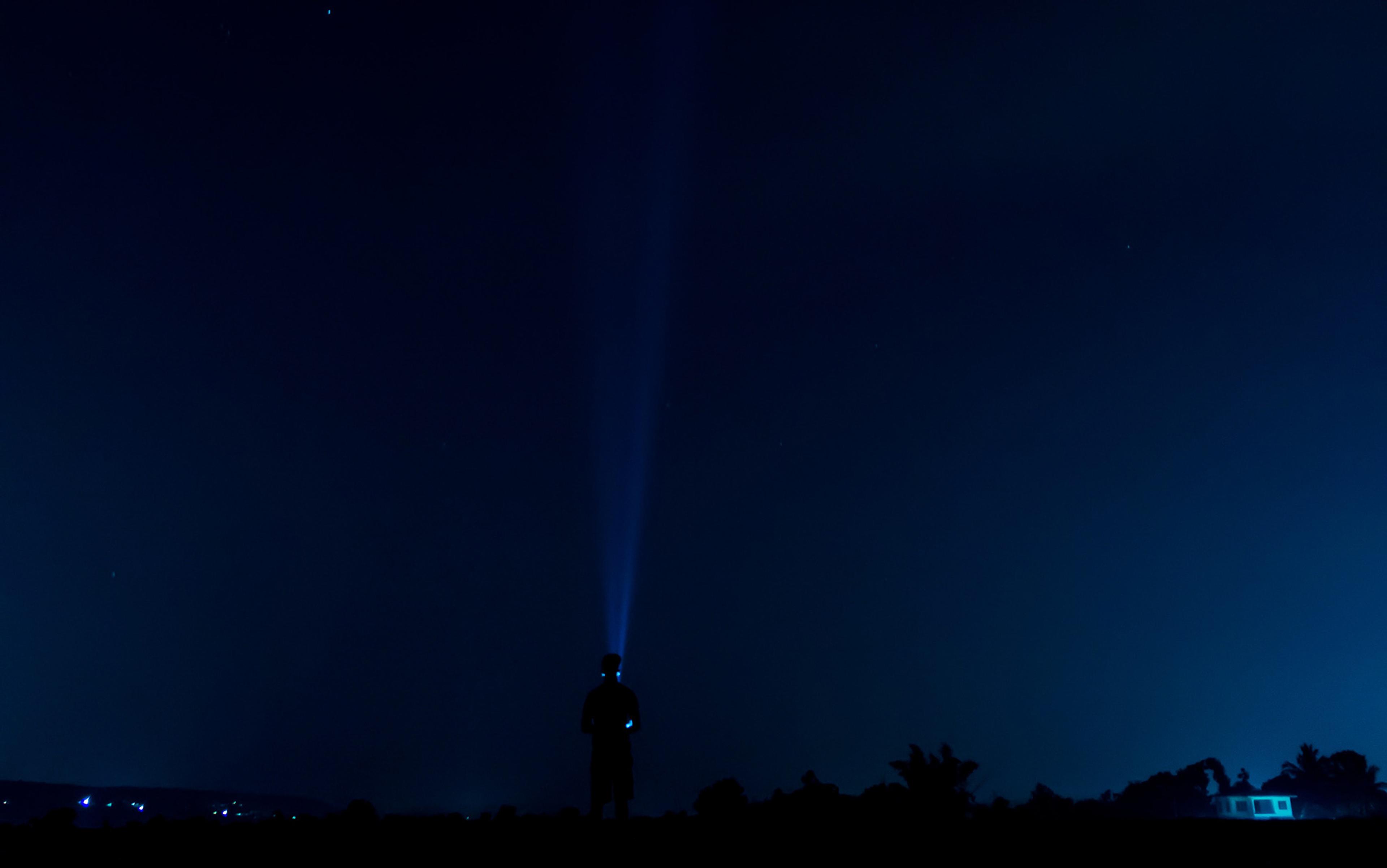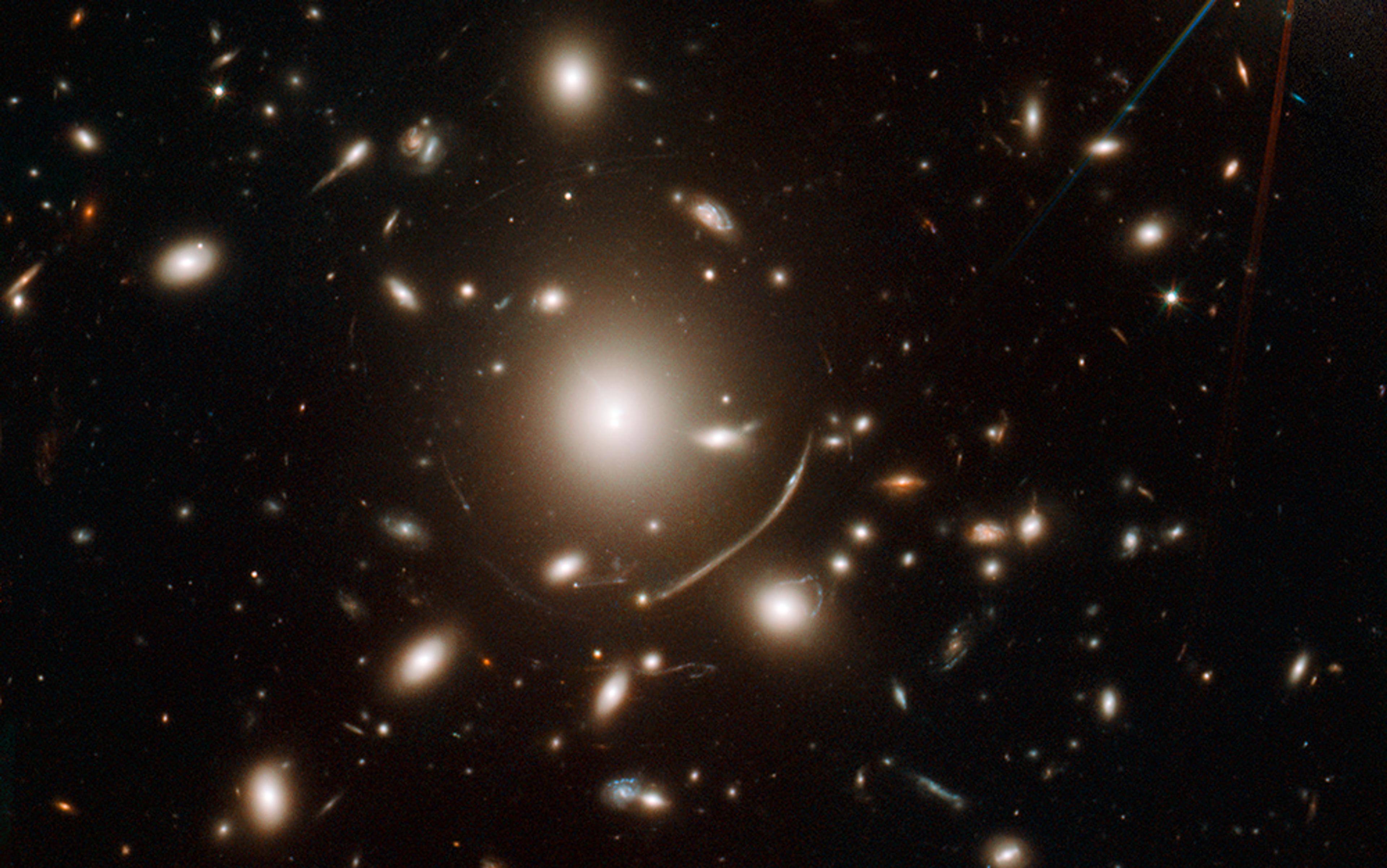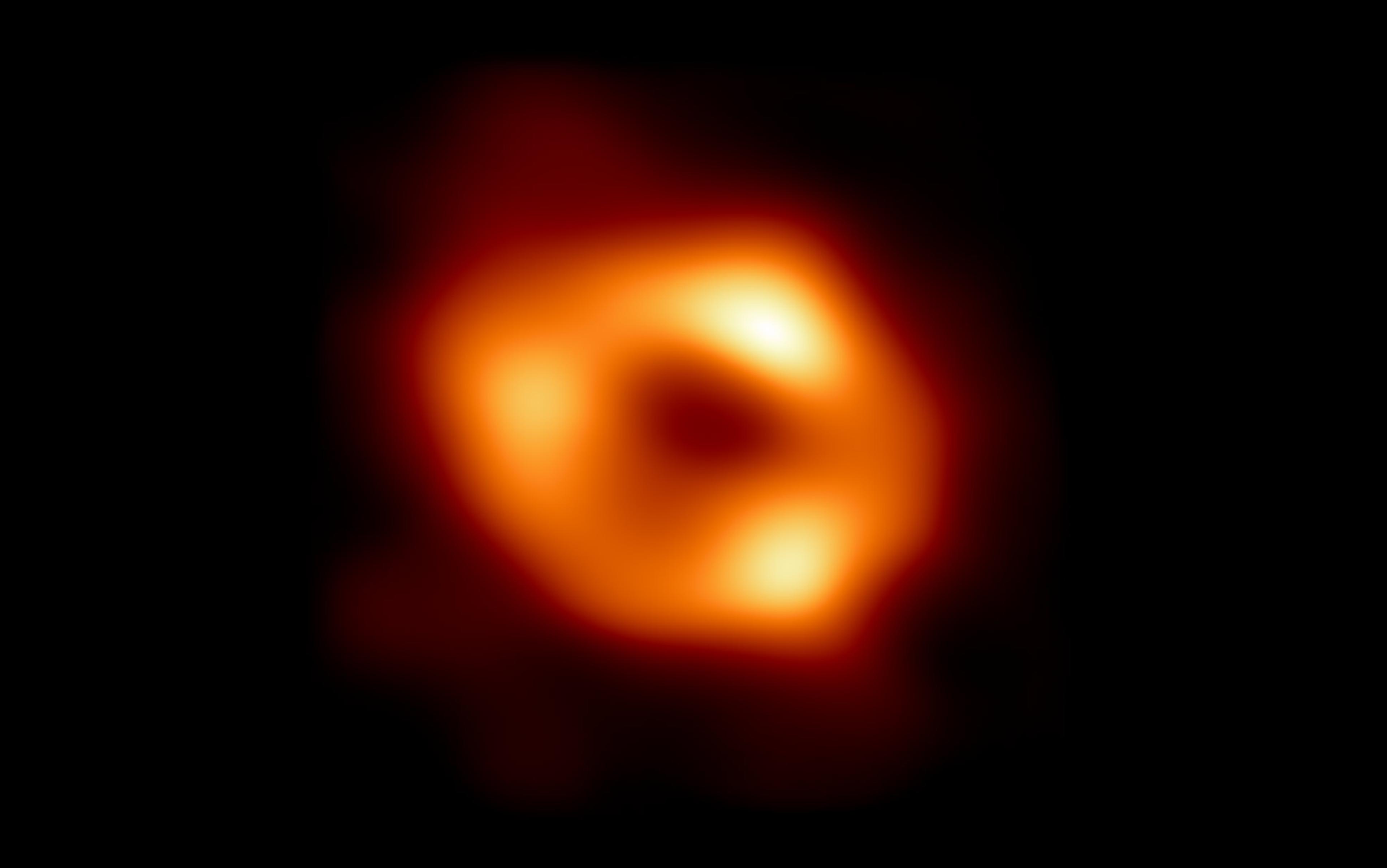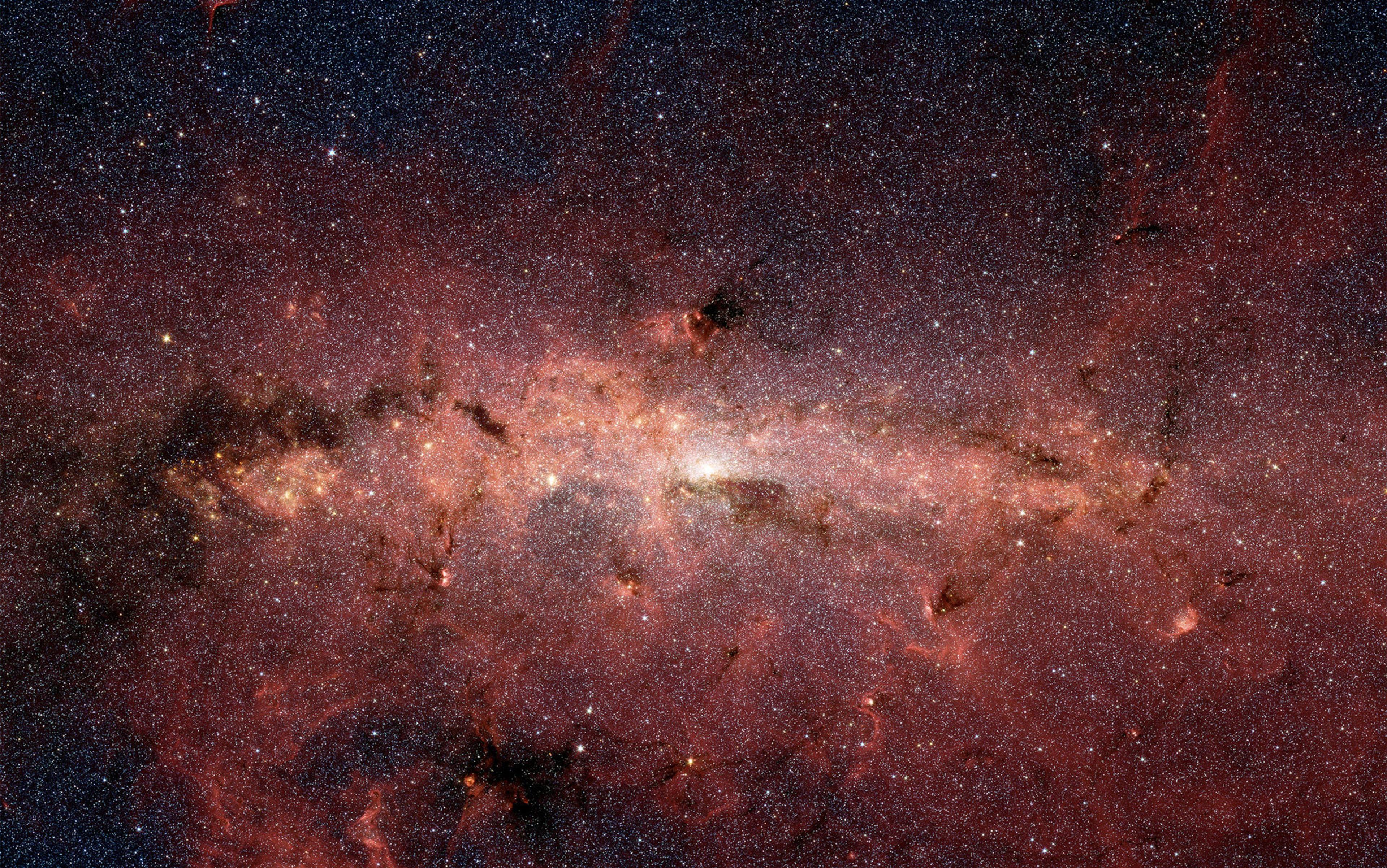In 1969, the American astronomer Vera Rubin puzzled over her observations of the sprawling Andromeda Galaxy, the Milky Way’s biggest neighbour. As she mapped out the rotating spiral arms of stars through spectra carefully measured at the Kitt Peak National Observatory and the Lowell Observatory, both in Arizona, she noticed something strange: the stars in the galaxy’s outskirts seemed to be orbiting far too fast. So fast that she’d expect them to escape Andromeda and fling out into the heavens beyond. Yet the whirling stars stayed in place.
Rubin’s research, which she expanded to dozens of other spiral galaxies, led to a dramatic dilemma: either there was much more matter out there, dark and hidden from sight but holding the galaxies together with its gravitational pull, or gravity somehow works very differently on the vast scale of a galaxy than scientists previously thought.
Her influential discovery never earned Rubin a Nobel Prize, but scientists began looking for signs of dark matter everywhere, around stars and gas clouds and among the largest structures in the galaxies in the Universe. By the 1970s, the astrophysicist Simon White at the University of Cambridge argued that he could explain the conglomerations of galaxies with a model in which most of the Universe’s matter is dark, far outnumbering all the atoms in all the stars in the sky. In the following decade, White and others built on that research by simulating the dynamics of hypothetical dark matter particles on the not-so-userfriendly computers of the day.
But despite those advances, over the past half century, no one has ever directly detected a single particle of dark matter. Over and over again, dark matter has resisted being pinned down, like a fleeting shadow in the woods. Every time physicists have searched for dark matter particles with powerful and sensitive experiments in abandoned mines and in Antarctica, and whenever they’ve tried to produce them in particle accelerators, they’ve come back empty-handed. For a while, physicists hoped to find a theoretical type of matter called weakly interacting massive particles (WIMPs), but searches for them have repeatedly turned up nothing.
With the WIMP candidacy all but dead, dark matter is apparently the most ubiquitous thing physicists have never found. And as long as it’s not found, it’s still possible that there is no dark matter at all. An alternative remains: instead of huge amounts of hidden matter, some mysterious aspect of gravity could be warping the cosmos instead.
The notion that gravity behaves differently on large scales has been relegated to the fringe since Rubin’s and White’s heyday in the 1970s. But now it’s time to consider the possibility. Scientists and research teams should be encouraged to pursue alternatives to dark matter. Conferences and grant committees should allow physicists to hash out these theories and design new experiments. Regardless of who turns out to be right, such research on alternatives ultimately helps to crystallise the demarcation between what we don’t know and what we do. It will encourage challenging questions, spur reproducibility studies, poke holes in weak spots of the theories, and inspire new thinking about the way forward. And it will force us to decide what kinds of evidence we need to believe in something we cannot see.
We have been here before. In the early 1980s, the Israeli physicist Mordehai ‘Moti’ Milgrom questioned the increasingly popular dark matter narrative. While working at an institute south of Tel Aviv, he studied measurements by Rubin and others, and proposed that physicists hadn’t been missing matter; instead, they’d been wrongly assuming that they completely understood how gravity works. Since the outer stars and gas clouds orbit galaxies much faster than expected, it makes more sense to try to correct the standard view of gravity than to conjure an entirely new kind of matter.
Milgrom proposed that Isaac Newton’s second law of motion (describing how the gravitational force acting on an object varies with its acceleration and mass) changes ever so slightly, depending on the object’s acceleration. Planets such as Neptune or Uranus orbiting our sun, or stars orbiting close to the centre of our galaxy, don’t feel the difference. But far in the outlying areas of the Milky Way, stars would feel a smaller gravitational force than previously thought from the bulk of matter in the galaxy; adjusting Newton’s law could provide an explanation for the speeds Rubin measured, without needing to invoke dark matter.
Developing the paradigm of a dark-matter-less universe became Milgrom’s life project. At first, he worked mostly in isolation on his proto-theory, which he called Modified Newtonian Dynamics (MOND). ‘For more than a few years, I was the only one,’ he says. But slowly other scientists circled round.
He and a handful of others first focused on rotating galaxies, where MOND accurately describes what Rubin observed at least as well as dark matter theories do. Milgrom and colleagues then expanded the scope of their research, predicting a relationship between how fast the outside of a galaxy rotates and the galaxy’s total mass, minus any dark matter. The astronomers R Brent Tully and J Richard Fisher measured and confirmed just such a trend, which many dark matter models have struggled to explain.
When space-time gets curved in a particular way it creates the illusion of dark matter
Despite these successes, Milgrom’s modification of Newton’s second law remained just an approximation, causing his ideas to fall short of requirements for a full-fledged theory. That began to change when Milgrom’s colleague Jacob Bekenstein at the Hebrew University of Jerusalem extended MOND to show it could be consistent with Albert Einstein’s theory of general relativity, which predicts that gravity has the power to bend light rays, an idea proven just over a century ago, during a solar eclipse in 1919, and today known as ‘gravitational lensing’.
Around the same time, the American astronomer Edwin Hubble noticed that his colleagues had considered that close groups of gas clouds were actually far more distant galaxies. Building on Hubble’s discovery, other astronomers demonstrated the existence of larger cosmic structures now known as galaxy clusters, which have the power to act like powerful lenses, strongly bending light rays. Using formulas based on predictions by Einstein, it’s possible to infer the mass of a cosmic lens. Based on this mathematics, many physicists used gravitational lensing as an argument for the existence of dark matter. But Bekenstein showed that general relativity and MOND could also explain at least some lensing measurements that have been made.
Even so, these ideas were only partly formed. Indeed, Milgrom and Bekenstein still didn’t know what in physics could create a modified law of gravity.
MOND lacked much of a foundation until a few years ago, when the Dutch physicist Erik Verlinde began developing a theory known as ‘emergent gravity’ to explain why gravity was altered. In Verlinde’s view, gravity, including MOND, emerges as a kind of thermodynamic effect, related to increasing entropy or disorder. His ideas build on quantum physics as well, viewing space-time and the matter within it as originating from an interconnected array of quantum bits. When space-time gets curved, it produces gravity, and if it’s curved in a particular way, it creates the illusion of dark matter.
Verlinde’s research is still waiting to be fleshed out. It’s still not clear, for instance, how modified or emergent gravity can make sense of the structure of the young Universe, discerned from relic radiation left behind from the Big Bang. Astrophysicists have used space telescopes to map out that radiation in incredible detail, but they haven’t yet found a way to make models without dark matter consistent with the measurements. ‘It’s not like this idea of emergent gravity can compete yet,’ Verlinde says, but in time it could become a real alternative to dark matter.
Dark matter theories make predictions too: if this form of matter exists, numerous subatomic dark matter particles should be frequently whizzing through our solar system, through the Earth, and even occasionally zipping through our bodies. But if huge amounts of dark matter indeed exist, enshrouding every galaxy in the Universe while being unseen and unfelt everywhere, then the elusive little particles typically won’t interact with normal matter in a way that anyone would notice. That makes actually detecting them a formidable task.
While astrophysicists kept their eyes trained on the heavens, particle physicists sought to shed light on dark matter by creating plausible particles in their accelerators, like the powerful Large Hadron Collider (LHC) in Geneva, Switzerland. Intended to recreate such conditions as at the Big Bang, the LHC smashes particles together at great speeds so that, in bursts of energy, it produces new particles. Those particles pass through a series of detectors, which allow physicists to identify them.
With the LHC and its predecessors, for example, at Fermilab west of Chicago, scientists managed to find all 17 particles predicted by the ‘standard model’ of particle physics, which includes all of the fundamental forces other than gravity. (They spotted the last standard particle, the Higgs boson, with the LHC in 2012.) Because of this string of successes, physicists were bullish about soon discovering dark matter particles as well, writes Dan Hooper, a Fermilab physicist, in his book At the Edge of Time (2019).
Interest in dark matter spawned a new generation of experiments, which Hooper and his colleagues hoped would finally pin down the mysterious particles. Scientists around the world built detectors deep beneath the Earth, often repurposing old mines, with the aim of finding dark matter particles while avoiding the cacophonous noise of cosmic rays and solar particles that would bombard any detector above ground. Dark matter particles could silently flit through a detector made of xenon or other materials and leave a sign of their passing in the form of heat, the researchers hypothesised. If the experiments fared as planned, scientists would finally spot dark matter particles and herald a new era of cosmology and particle physics.
If dark matter particles exist, it will be extremely difficult to catch any glimpse of them
But the experiments haven’t turned up any positive signs, and researchers’ initial hopes have been dashed. In fact, experiments unable to find a hint of dark matter have ultimately shown evidence only of what dark matter is not. With each new experiment, the range of not-dark-matter has grown. Physicists have begun to understand that, if dark matter particles exist, it will be extremely difficult to catch any glimpse of them.
In particular, the situation looks bleak for WIMPs, which had been the most popular dark matter candidate. Researchers kept broadening their search, seeking ever-lower mass particles, and then even smaller particles, but continued to find nothing. A few teams continue the hunt for WIMPs with ever-more sensitive detectors, but in a few years they’ll reach the tiniest mass range, when any putative dark matter particle would interact with a detector similarly to how wispy neutrinos from the Sun do, effectively bringing the WIMP search to a screeching halt. ‘Then we will be done. You can see the end is in sight for the WIMPs. That may make people try to think of new things,’ says Peter Graham, a theoretical physicist at Stanford University in California.
But if the end is nigh for WIMPs, it’s certainly not the end of the story for dark matter searches, Graham argues. Scientists are already beginning to flock to other viable particles, especially axions. If they exist, axions would be billions of times less massive than WIMPs, and so they’d have to be incredibly abundant to add up to the expected mass of dark matter. Other, arguably more exotic candidates include so-called ‘sterile neutrinos’ and tiny primordial black holes, a version of MACHOs (for ‘massive compact halo objects’).
A few scientists, including Hooper, have even proposed hypothetical particles that experience hidden forces. These dark particles, if they exist, would annihilate and then decay into other particles that might somehow be coupled to known particles such as the Higgs boson. It’s plausible, but no one has made a clear detection of any of these hidden particles or forces yet.
As searches for dark particles falter, Milgrom has seen more physicists open to modified gravity in recent years. ‘People are not quite disillusioned, but there is a lot of disappointment with the fact that dark matter has not been detected,’ he said. ‘To me, that’s not the best reason to work on MOND, but I’m glad to see more interest.’ Whether this interest eventually translates into expanding research on modified gravity remains to be seen.
Hundreds if not thousands of astrophysicists, astronomers and particle physicists now study every aspect of dark matter and every imprint it might have on the cosmos, with state-of-the-art computers, telescopes and particle accelerators. Dark matter research has dwarfed modified gravity research for decades, but it doesn’t necessarily mean that dark matter is that much more convincing a theory. Instead, early on, some scientists thought it was a natural solution, others followed their view, and the scales tilted to their side.
Today’s seeming dominance of dark matter wasn’t inevitable. The processes through which scientists develop theories are heavily influenced by all sorts of historical and sociological factors, a point eloquently made by Andrew Pickering, emeritus philosopher of science at the University of Exeter and the author of Constructing Quarks (1984), a 36-year-old book that’s still relevant today.
It’s important to pay attention to who decides which phenomena to study, which research earns major government grants, which big experiments get funded, who gets speaking opportunities at scientific conferences, who is media savvy, who wins prominent fellowships and awards, and who gets promoted to high-profile faculty positions. Different choices sometimes can shape the future trajectory of science. And when choices by theorists and experimentalists coincide symbiotically, Pickering argues, it can be challenging for an upstart theory – such as modified gravity – to get a fair hearing.
The enterprise of science isn’t a particularly efficient or straightforward path toward ‘the truth’. Nevertheless, we need not despair, argues Naomi Oreskes, a historian of science at Harvard University in Massachusetts and the author of the book Why Trust Science? (2019). Though individual scientists are fallible and have their own values and goals and, occasionally, axes to grind, science as a collective affair goes on. Researchers might make missteps here and there, they might take a long time to rigorously vet some claims and establish others, and maybe a seemingly promising research programme reaches a dead end, but over time, scientists gradually build a consensus. It usually takes a while, but they eventually figure out which research paths should be left behind, and which ideas need to be studied further and refined.
For dark matter versus modified gravity, this process hasn’t finished playing out. Dark matter is currently ascendant but the debate’s not over. The stakes are large, since the future of cosmology depends on the choices that astrophysicists make next.
Modified gravity scientists such as Milgrom and Verlinde face daunting challenges before having a real chance of developing their ideas into a valid alternative to dark matter. The biggest obstacle comes from the beginning of the Universe.
The astronomers Arno Penzias and Robert Wilson in the 1960s at first misinterpreted their radio telescope’s faint static as noise – perhaps due to pigeons roosting and leaving droppings on it. But the signal turned out to be real, and they confirmed their discovery of relic radio waves that date back to soon after the Big Bang. Then in the 1980s and ’90s, Soviet and NASA scientists used their own space telescopes, RELIKT-1 and COBE, to spot tiny wiggles in that radiation. John Mather and George Smoot, the physicists who led the COBE research, won the Nobel Prize in Physics 2006 for measuring those little radiation variations, which translate into early density differences that determined where the matter in the Universe collected and structures of galaxies formed.
They predict far more dark matter clumps than suggested by the meagre number of satellite galaxies spotted so far
Mather and Smoot’s successors have now measured the wiggles in relic radio radiation to exquisite precision, and any successful theory has to offer an explanation of them. Dark matter physicists have already shown that their theory could reproduce all of those wiggles quite well, but modified or emergent gravity has failed that critical test – so far. Bekenstein died in 2015, but his successors are still trying to make his modified gravity theory consistent with at least some of the measurements. That would be a big leap forward and a compelling one for skeptics of modified gravity, but it’s a major task that has yet to be done.
Of all the pieces of evidence, those wiggles are the strongest. Dark matter is clearly winning. It took decades of work by hundreds of dark matter scientists and huge investment in their research programmes to develop models that could explain all those measurements. Modified and emergent gravity, with lower levels of funding, remain far behind, but that doesn’t mean they should be abandoned. ‘My contention is that it’s very unlikely that emergent gravity is responsible for the phenomena we currently attribute to dark matter,’ Hooper says, ‘but it doesn’t mean that gravity isn’t emergent or that it’s not something worth exploring.’
Furthermore, dark matter researchers such as White and Hooper have their own problems to grapple with. Giant galaxies, including our own, typically have a handful of smaller galactic companions orbiting them like satellites. If dark matter physicists are right, each of those galaxies should be embedded within a huge clump of dark matter since dark matter particles and the galaxies’ stars should be drawn together by the same gravitational forces. But the latest computer simulations developed by White and his colleagues have some glaring differences with astronomers’ observations: they predict far more dark matter clumps than suggested by the meagre number of satellite galaxies spotted so far. Physicists tellingly call this the ‘missing satellites problem’, since reality doesn’t seem to match those theorists’ expectations.
At much larger, cosmic scales, astrophysicists are also trying to explain a recent, puzzling discrepancy: that the Universe today seems to be expanding dramatically more rapidly than it did in its infancy. Physicists had expected the rate of expansion (called the Hubble constant) to be the same everywhere, but now they need to explain the disparity. With dark matter theorists unable to resolve the conundrum, Verlinde says perhaps emergent gravity will offer a path ahead.
Verlinde, Milgrom and their colleagues are still a small minority, but cosmology will benefit if their ranks grow. They’re already finding a few scientists in the dark matter community to be receptive to their ideas. At a recent conference he attended, Verlinde noticed a palpable shift in acceptance. ‘I felt like there was more communication and more willingness to discuss alternatives than years before,’ he says.
Beyond this theoretical work, physicists expect bigger, better telescopes and experiments to bear fruit, including the Large Synoptic Survey Telescope, being built in the dry mountains of northern Chile. This year, scientists renamed it the Vera C Rubin Observatory, and it will have ‘first light’ next year. Inspired by Rubin’s work, researchers will peer wider and deeper into the heavens, mapping the light of billions of galaxies. If they keep an open mind, their studies could illuminate both dark matter and dark forces of gravity. Rubin’s namesake will continue provoking healthy debates about the vast hidden universe we yearn to further explore.
This Essay was made possible through the support of a grant to Aeon from the John Templeton Foundation. The opinions expressed in this publication are those of the author and do not necessarily reflect the views of the Foundation. Funders to Aeon are not involved in editorial decision-making.
